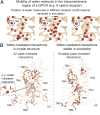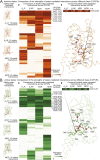Diverse GPCRs exhibit conserved water networks for stabilization and activation
- PMID: 30728297
- PMCID: PMC6386714
- DOI: 10.1073/pnas.1809251116
Diverse GPCRs exhibit conserved water networks for stabilization and activation
Abstract
G protein-coupled receptors (GPCRs) have evolved to recognize incredibly diverse extracellular ligands while sharing a common architecture and structurally conserved intracellular signaling partners. It remains unclear how binding of diverse ligands brings about GPCR activation, the common structural change that enables intracellular signaling. Here, we identify highly conserved networks of water-mediated interactions that play a central role in activation. Using atomic-level simulations of diverse GPCRs, we show that most of the water molecules in GPCR crystal structures are highly mobile. Several water molecules near the G protein-coupling interface, however, are stable. These water molecules form two kinds of polar networks that are conserved across diverse GPCRs: (i) a network that is maintained across the inactive and the active states and (ii) a network that rearranges upon activation. Comparative analysis of GPCR crystal structures independently confirms the striking conservation of water-mediated interaction networks. These conserved water-mediated interactions near the G protein-coupling region, along with diverse water-mediated interactions with extracellular ligands, have direct implications for structure-based drug design and GPCR engineering.
Keywords: GPCR dynamics; activation; molecular dynamics simulation; polar network; water molecules.
Copyright © 2019 the Author(s). Published by PNAS.
Conflict of interest statement
Conflict of interest statement: B.K.K. is a cofounder of and consultant for ConfometRx, Inc.
Figures




References
-
- Fredriksson R, Lagerström MC, Lundin L-G, Schiöth HB. The G-protein-coupled receptors in the human genome form five main families. Phylogenetic analysis, paralogon groups, and fingerprints. Mol Pharmacol. 2003;63:1256–1272. - PubMed
-
- Venkatakrishnan AJ, et al. Molecular signatures of G-protein-coupled receptors. Nature. 2013;494:185–194. - PubMed
Publication types
MeSH terms
Substances
Grants and funding
LinkOut - more resources
Full Text Sources

